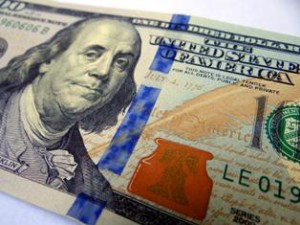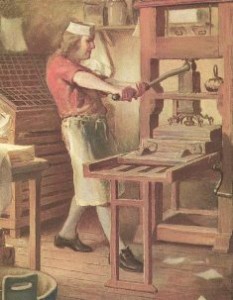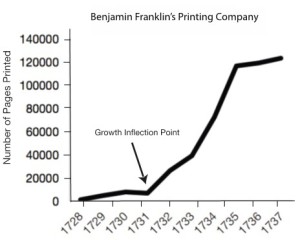This is the third in a three part series on how Ben Franklin’s startup story teaches us that the methods by which startups are conceived, grown, and evolved are timeless.
 Hitting the Growth Inflection Point
Hitting the Growth Inflection Point
For five years, from 1724 to 1729, Ben had been a struggling founder who was attempting to find his way. He tried to open a business for two or three years without success, and then when he did open for business, he struggled with a lazy partner and debts. But Ben was a creative bootstrapper and learned methods to do work himself in order to save money, pay off loans, and eek by.
Much of Ben Franklin’s printing success in those early years was the result of his marketing creativity. He created popular writings that were remarkable and memorable—which he’d print and sell for a profit. He wrote like a modern-day blogger—providing entertaining, useful content in several subject areas. In 1733, under the pseudonym Richard Saunders, Franklin offered witty, worldly wisdom such as, “He’s a fool that makes his doctor his heir,” through his widely-read pamphlet Poor Richard’s Almanac.[i] To stand out, Franklin was the first to print cartoons and maps with his essays, the visuals increasing the appeal of his words.[ii]
Poor Richard helped Franklin’s printing business as its circulation grew to more than 10,000—keeping his presses busy. His creative content also helped him improve revenue at the Pennsylvania Gazette, the newspaper he had purchased, where advertising grew 42.5 percent under Ben’s management.[iii] This success also helped Franklin obtain larger print jobs, including being public printer for New Jersey and Delaware.
Five years after opening, Franklin’s forward-thinking print shop was now gaining momentum and was close to hitting a growth inflection point: “My business was now continually augmenting, and my circumstances growing daily easier, my newspaper having become very profitable…. I experienced, too, the truth of the observation, ‘that after getting the first hundred pound, it is more easy to get the second,’ money itself being of a prolific nature.”[iv]
Surging Growth
Like many innovative businesses today, Franklin’s growth was also a result of his ability to duplicate good ideas. In 1733, Franklin entered into his first successful partnership with aspiring printers in other geographic locations. “The partnership at [South] Carolina having succeeded, I was encourag’d to engage in others, and to promote several of my workmen, who had behaved well, by establishing them with printing-houses in different colonies, on the same terms with that in Carolina. Most of them did well, being enabled at the end of our term, six years, to purchase the types of me and go on working for themselves, by which means several families were raised.”[v]
By 1748, when Franklin was 42 years old, his startup had grown into an empire of printing presses and publishing houses. Ready to take on new challenges, Franklin sold his printing company to his foreman, David Hall, in exchange for half the company’s profits for 18 years. Franklin’s payoff amounted to about 650 pounds annually ($943,044 in today’s dollars[vi]), after which he went on to discover processes, invent useful products, and play an important political role in effecting America’s independence from England by 1783 when the Treaty of Paris was signed.
The growth process of Benjamin Franklin’s printing startup resembles that of today’s innovative business startups. His success wasn’t predicated on detailed planning that, once followed, resulted in a quick success.
We unfortunately don’t have records of Franklin’s Printing Company’s annual revenue. As an alternative, I charted the estimated number of pages his company printed each year.[vii]
Every business you or I start today, therefore, is likely to follow the same growth curve as Ben’s printing business, one that calls for the same unflagging hard work, self-disciplined resilience to recover from periodic setbacks, and the fun of applying creative problem-solving in different ways again and again.
[i] (Franklin) 1733)
[ii] (Independence Nat’l Historical Park 2012)
[iii] (Miller 1974)
[iv] (Franklin 1996) p.51
[v] (Franklin 1996) p.51
[vi] Currency Conversion
[vii] Franklin’s Printwork.
Sign up to get more great insights directly to your inbox.
As a special bonus, you'll also immediately get access to my inside analysis of what made 172 diverse companies achieve take-off revenue growth.


